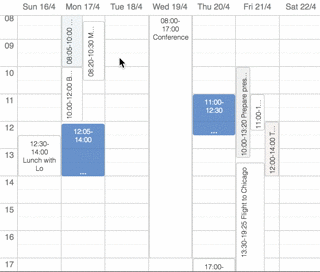React Available Times
A React component that allows a user to select time-slots in a calendar-like UI.

Installation
npm install --save react-available-times
Usage
import AvailableTimes from 'react-available-times'; <AvailableTimes ="monday" = = = = = = = =/>Props
None of the props are required.
weekStartsOn: a string (either"monday"or"sunday") specifying what day of the week should come first.calendars: a list of calendars displayed in the dropdown at the top right.onChange: a function called whenever a selection is made. Receives an array of objects, each with astartand anenddate.onEventsRequested: a function called when new weeks are loaded. Hook in to this function to continuously feed events to the calendar view. Thecallbackprovided should be called when you have fetched events for the particularcalendarId. Call the callback with an array of objects, where each object has astartand anenddate, plus atitleproperty. Can have acalendarIdproperty tying them to a calendar, inheriting the foreground and background color. Can also have aallDayproperty, in which case they are rendered at the top.initialSelections: an array of pre-filled selections. Each object in the array needs astartand anenddate.height: a string or a number controlling theheightof the component. E.g.'100%',350,'100vh'. If left out, the full height of the screen will be used.recurring: set totrueto turn the view into a selector for recurring availability. No dates are then shown, and theonChangecallback is called with events that have a start and end expressed in number of minutes since the start of the week. TheweekStartsOnprop is taken into account here, so the0minute is either monday at 00:00 or sunday at 00:00.availableDays: an array of strings ("monday","tuesday"...) specifying what days of the week are available to be used. It is set to every day by default.availableHourRange: an object withstartandendnumbers, ranging from 0 to 24 inclusive. Defaults to the entire day by default.
Contributing
First, run npm install to install all dependencies. Then, to manually test
the component, run npm run start-test and open http://localhost:3333/ in a
browser.
Unit tests are run with jest. Run npm run test -- --watch to run tests.